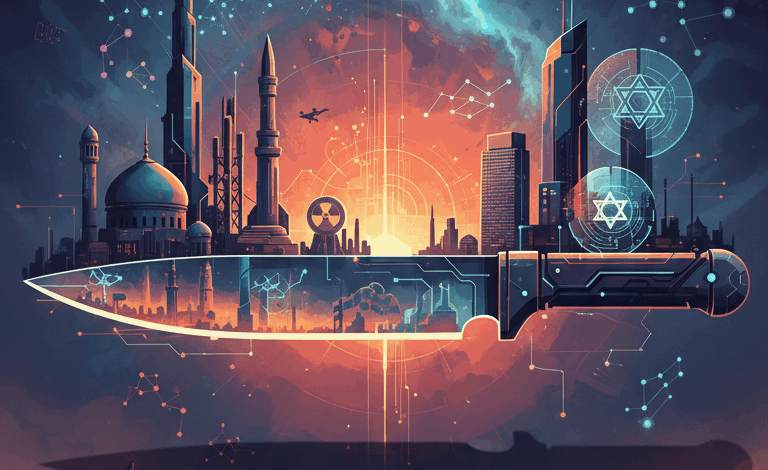The Middle East on a Knife-Edge: Unpacking the Iran-Israel Confrontation

Introduction: From Shadow Games to Open Warfare
The Middle East, a perpetual crucible of geopolitical tensions, has witnessed a chilling escalation in the already fraught relationship between Iran and Israel. The theater of conflict has shifted dramatically, from the veiled maneuvers of proxy wars to the stark reality of direct missile exchanges. The brief but intense “Twelve-Day War” of June 2025 serves as a stark reminder of the precipice upon which the region teeters.
This isn’t merely another skirmish in a long line of regional conflicts. It’s a qualitative leap in a decades-long rivalry, an overt manifestation of hostilities that carries profound implications for global stability. To understand the gravity of the current situation, one must delve into the historical currents that have shaped this antagonism.
A Look Back: When Iran and Israel Were…Friends?
It requires a considerable leap of imagination to envision Iran and Israel as allies, yet historical reality often defies contemporary perceptions. Prior to 1979, these two nations were strategic partners. Under the Shah’s rule, Iran, surprisingly, was the second Muslim-majority country to extend recognition to Israel. This alliance was underpinned by shared strategic interests, including intelligence cooperation, the exchange of military technology, and even the flow of Iranian oil to Israel. The “Periphery Doctrine,” aimed at countering Arab nationalism, further solidified this unlikely bond.
The 1979 Islamic Revolution triggered a seismic shift in the regional landscape. Ayatollah Khomeini’s denunciation of Israel as the “Small Satan” marked the severing of all ties. The Israeli embassy in Tehran was symbolically transformed into the PLO’s headquarters, and anti-Zionism became a central pillar of Iran’s foreign policy. The seeds of the modern conflict were sown.
From the 1980s to the early 2020s, the conflict largely unfolded in the shadows. Iran, lacking the overt capacity to directly engage Israel, opted to exert influence through proxies such as Hezbollah in Lebanon and Hamas in Gaza. Israel, in turn, responded with covert operations, assassinations, and a relentless campaign to thwart Iran’s nuclear ambitions, which it deemed an “existential threat”.
The Firestorm of 2024-2025: When Shadows Became Direct Strikes
April 2024 marked a turning point, a departure from the established norms of engagement. An Israeli airstrike on Iran’s consulate in Damascus prompted an unprecedented response: direct missile and drone attacks on Israeli territory. Israel retaliated in kind, shattering the illusion of indirect conflict and ushering in a new, dangerous era of open confrontation.
The period between July and September 2024 witnessed a wave of assassinations, targeting key figures such as Hamas leader Ismail Haniyeh and Hezbollah’s Hassan Nasrallah. While Israel neither confirmed nor denied its involvement, these actions were widely attributed to Israeli intelligence, further escalating tensions and weakening Iran’s network of regional allies, the “Axis of Resistance.”
In October 2024, Iran launched another large-scale missile attack on Israel, only to be met with a swift and forceful counter-strike. Reports indicated that the Israeli response damaged Iran’s Russian-supplied S-300 missile system, though Iranian authorities vehemently denied these claims. The stage was set for a more comprehensive confrontation.
The “Twelve-Day War” of June 2025 represented the culmination of these escalating tensions. Israel’s “Operation Rising Lion” aimed at preemptively dismantling Iran’s nuclear and military capabilities, with strikes targeting nuclear facilities and key leadership figures. Iran responded with “Operation True Promise III,” unleashing a barrage of ballistic missiles and drones against Israeli civilian and military targets.
The United States, under increasing pressure to intervene, directly engaged Iranian nuclear sites, resulting in Iran retaliating by striking a US base in Qatar. A fragile ceasefire, brokered under intense US pressure, brought an end to the fighting, but only after widespread destruction and a significant economic toll on both sides.
The Nuclear Elephant in the Room and Other Controversies
Iran’s nuclear program remains the most volatile element in this already explosive mix. Israel views a nuclear-armed Iran as an existential threat, justifying its preemptive military actions. Iran, on the other hand, maintains that its nuclear program is for peaceful purposes only. However, reports from the International Atomic Energy Agency (IAEA) in June 2025 indicated that Iran had amassed enough enriched uranium for multiple warheads, casting serious doubt on these claims. The question of intent hangs heavy in the air.
Accusations of war crimes have become a regular feature of the conflict. Iran accuses Israel of deliberately targeting civilians, hospitals, and nuclear facilities, branding these actions as “grave war crimes.” Israel, in turn, accuses Iran of sponsoring terrorism and actively seeking its destruction.
The “Axis of Resistance,” Iran’s network of regional proxies, has suffered significant losses, raising concerns about Iran’s ability to project power in the region. The assassination of key leaders and the destruction of infrastructure have weakened these groups, potentially altering the balance of power in the Middle East.
Beyond the conventional battlefield, a shadowy war of cyberattacks and maritime sabotage continues, targeting critical infrastructure and oil routes. These covert operations add another layer of complexity to the conflict, making attribution difficult and increasing the risk of miscalculation.
Iran has accused the United States of providing Israel with an “air corridor” and enabling its attacks, underscoring the international dimensions of the conflict. The perception of US complicity further fuels anti-American sentiment in the region and complicates diplomatic efforts.
What’s Next? A Precarious Future
The risk of re-escalation remains high. Despite the damage inflicted during the June 2025 war, Iran is reportedly only a year or two away from restoring its nuclear capabilities. Both sides are actively addressing vulnerabilities exposed during the conflict, making future confrontations all but inevitable.
Diplomatic efforts face an uphill battle. While international and regional actors, including the United States under a renewed Trump administration, are attempting to revive negotiations, deep-seated mistrust and hardened resolve make breakthroughs exceedingly difficult. The imposition of UN sanctions on Iran in October 2025 further complicates the situation.
Israel’s apparent commitment to continuous, preemptive military action, often referred to as “mowing the grass,” suggests that the cycle of violence is unlikely to end anytime soon. This doctrine, while aimed at containing Iran’s capabilities, carries the risk of provoking a wider conflict.
Iran is expected to rebuild its proxy capabilities, potentially with support from Russia and China, ensuring continued regional tension. The flow of resources and expertise from these external actors could bolster Iran’s allies and further destabilize the region.
The conflict continues to have ripple effects far beyond the immediate combatants. Instability in the Middle East has the potential to disrupt global energy markets and draw in other major powers, with potentially catastrophic consequences.
Conclusion: A Region Holding Its Breath
The Iran-Israel confrontation has entered a new and dangerous phase, far removed from the “shadow wars” of the past. The stakes are higher than ever, fueled by historical grievances, ideological clashes, and the looming threat of nuclear proliferation.
The Middle East watches with bated breath, acutely aware that any miscalculation could ignite a wider, devastating regional conflagration with unimaginable consequences. The path forward remains uncertain, but one thing is clear: the region stands on a knife-edge, and the slightest tremor could send it spiraling into chaos.





